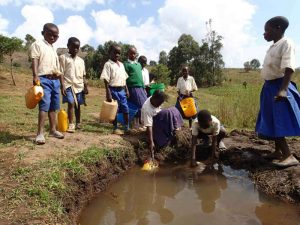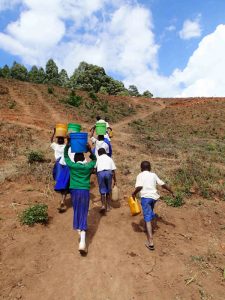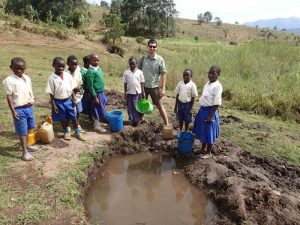 Location
Location
Kipapa Village, Mbinga District, Ruvuma Region, Tanzania
Community Description
Kipapa Village is located in southeastern Tanzania in Mbinga District, Ruvuma Region. It is approximately 95 km southwest of Mbinga town in Hagati Valley in the Matengo Mountains.
The village sits on a plateau at the northern end of the valley. Rolling coffee fields cover much of the cultivable land. The 3,000 people who live in Kipapa Village are from the Wamatengo tribe.
Malunga Primary School (Malunga Shule Msingi) is the only school in the sub-village of Malunga, the business and cultural hub of Kipapa. It is centrally located in the village and admits students grades 1-7. The school sits at a crossroads between three sub-villages and therefore sees much foot traffic.
 Kipapa is a farming community. Many families grow and sell coffee for profit. They grow corn and cassava for subsistence and for profit. Some farmers also raise livestock that is culled and sold in the village.
Kipapa is a farming community. Many families grow and sell coffee for profit. They grow corn and cassava for subsistence and for profit. Some farmers also raise livestock that is culled and sold in the village.
Aside from a few individual residences with generators, the community is complete without electricity. There is no public- or government-supplied water. There are mountain creeks and springs spread out throughout the village but many of them are dry for much of the year.
Some well-off families run plastic hoses from the springs to their homes for personal use. Some collect a fee from neighbors who use them for the convenience. A few people are able to collect small amounts of rainwater on their corrugated iron roofs but they are limited by the size and number of collection containers that are available.
Problem Addressed
Water becomes scarce during the 8-month-long dry season. Most families cannot spare enough water to have even a small garden, and nutrition suffers. Instead of supplementing their diets with fruits and vegetables, they usually “fill up” on starchy ugali.
People living with HIV/AIDS and malaria struggle to build their immune systems because of poor nutrition.
 The leading cause of sicknesses in children is the lack of access to potable drinking water.
The leading cause of sicknesses in children is the lack of access to potable drinking water.
There are no modern pumps or wells in the village. Most women and children spend one to four hours per day fetching water springs that are sometimes very far from their homes. They use this water for drinking, cleaning, cooking, bathing, washing dishes, mopping, and gardening.
At this time, there is little or no likelihood of a piped water supply becomes available. Therefore, roof water harvesting offers a path to improving water quality and availability.
The nearest water source from the Malunga Primary School is approximately .25 km away. The schoolchildren hike down the mountain to fetch water from a spring during the rainy season. However, during the rest of the year, the spring is dry. The children then collect fetid water from shallow mud-pits that are dug in the drainage. This water is used by the schoolchildren for drinking, cooking, and handwashing.
Project Description
This project is the construction of a rainwater catchment system at the primary school.
A 15,000-liter storage tank will be built based on plans from a study by the Swedish International Development Cooperation Agency (SIDA) called, “Low-Cost Methods of Rainwater Storage,” which built a total of ten tanks in Ethiopia and Kenya with various designs and materials.
The hemispherical tank will sit underground next to one of the school’s classroom buildings. An underground tank reduces the need for much of the reinforcing materials normally required when building an above-ground tank.
The pit for the tank will be lined with a strong foundation of mud bricks which the community itself will contribute. A waterproof cement-slurry will be plastered onto the bricks and serve as the interior walls of the tank.
To reduce the loss of water by evaporation and also to minimize the risk of pollutants and insect contamination, a roof will be made using a timber frame draped with a strong cloth reinforced with a thin layer of the cement mixture. A manhole 50 X 50 cm will be made in the roofs to facilitate the cleaning, removal of sediment, and the lowering of a bucket to remove the water.
A 75 mm diameter PVC overflow pipe will be installed, as well as a wire mesh 20 X 20 cm inlet to receive the piped-water harvested from the roof.
After clearing the site, the position of the center of the tank will be marked with a wooden peg and a string attached with the length of the outer radius of the tank. The students will then excavate the hole in a hemispherical shape using the peg and string. The soil will then be puddled with small amounts of water and dried grass, compacted, and allowed to slowly dry (cure) for a couple of days.
The mason will build the foundation and the brickwork in the shape of the tank. The overflow pipe will be fitted into this masonry.
A layer of cement will be applied to this layer at a thickness of 5-6 cm, done in two coats and allowed to dry over a period of two days. For waterproofing, a coat of cement and water slurry will be applied on the same day as the final coat of plaster.
The roof will be constructed and installed with the help of the mason to completely seal the tank.
Finally, corrugated iron will be cut and attached to the roof of the school building where it will serve as a rain-collecting gutter. These will be connected to the tank with a PVC pipe.
The schoolteachers have found two craftsmen who will provide their services at a discount.
Water Charity funds will be used to pay for materials, including twenty bags of cement, five sheets of corrugated iron, various carpentry supplies (such as wood and nails) for the roof, wire to attach the gutters, and PVC piping. The funds will also pay for the transport of all these materials from Mbinga town.
The village government will provide free mud bricks, and the school has offered to allow the oldest students to work for free as unskilled labor (such as digging and fetching water for cement).
Project Impact
The water catchment system will serve the primary school’s 500 students and teachers.
Peace Corps Volunteer Directing Project
Benjamin Manne
Comments
This is an important project using the appropriate technology. It results in a much larger storage tank within the budget than could be achieved using a plastic tank. It will provide for all of the water needs of the school, thus improving the health and well-being of students and faculty.
Dollar Amount of Project
$555.00
Donations Collected to Date
$555.00 + additional amounts for future projects
Dollar Amount Needed
$0.00 – This project has been fully funded through the generosity of Max Tribble, of Houston, TX, USA. Additional donations for future projects in Tanzania have been made by other friends and family of Peace Corps Volunteer Benjamin Manne.
This project has been concluded.
We encourage others to continue to donate using the Donate button below, and we will notify Benjamin of your donation. Additional funds will be used to fund the next project by Benjamin and/or those of other PCVs in the country of service.
![]()